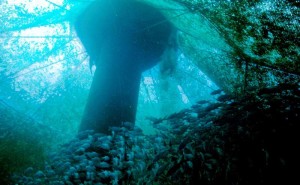By Emily Tripp, Publisher and Editor of MarineScienceToday.com
Aquaculture is one of the fastest growing sectors of agriculture in the world. It’s seen as a way to handle the increasing demand for seafood without putting additional pressure on wild fish populations. However, it has its own set of challenges, ranging from the food given to farm-raised fish to wastewater treatment.
A new study from the University of Illinois shows that a simple, organic system may clean aquaculture wastewater effectively and inexpensively.
In this new system, water from a fish tank enters a bioreactor (a long container filled with wood chips) at one end, flows through the wood chips, and exits through a pipe at the other end. While flowing through the container, solids settle and bacteria in the wood chips filter out nitrogen, which is a highly regulated pollutant.
The researchers compared four flow rates (the amount of time water has to flow from one end of the bioreactor to the other) and found that the optimal time was about 24 hours.
“The long and the short of it is that the bioreactors worked great,” Laura Christianson, assistant professor of water quality at the University of Illinois, lead author of the study, and bioreactor expert said. “They worked as a filter for the solids and took nitrates out. But for systems that need to move a lot of water in a short amount of time, we recommend an additional microscreen filter to settle some of the solids out before they enter and clog up the bioreactor.”
To learn more:
- Read the full news release: Nothing fishy about new solution for aquaculture wastewater treatment
- Read the study: Denitrifying bioreactor clogging potential during wastewater treatment
Reprinted from: http://marinesciencetoday.com/2017/03/17/wood-chips-clean-aquaculture/#ixzz4gmnyaJPi



